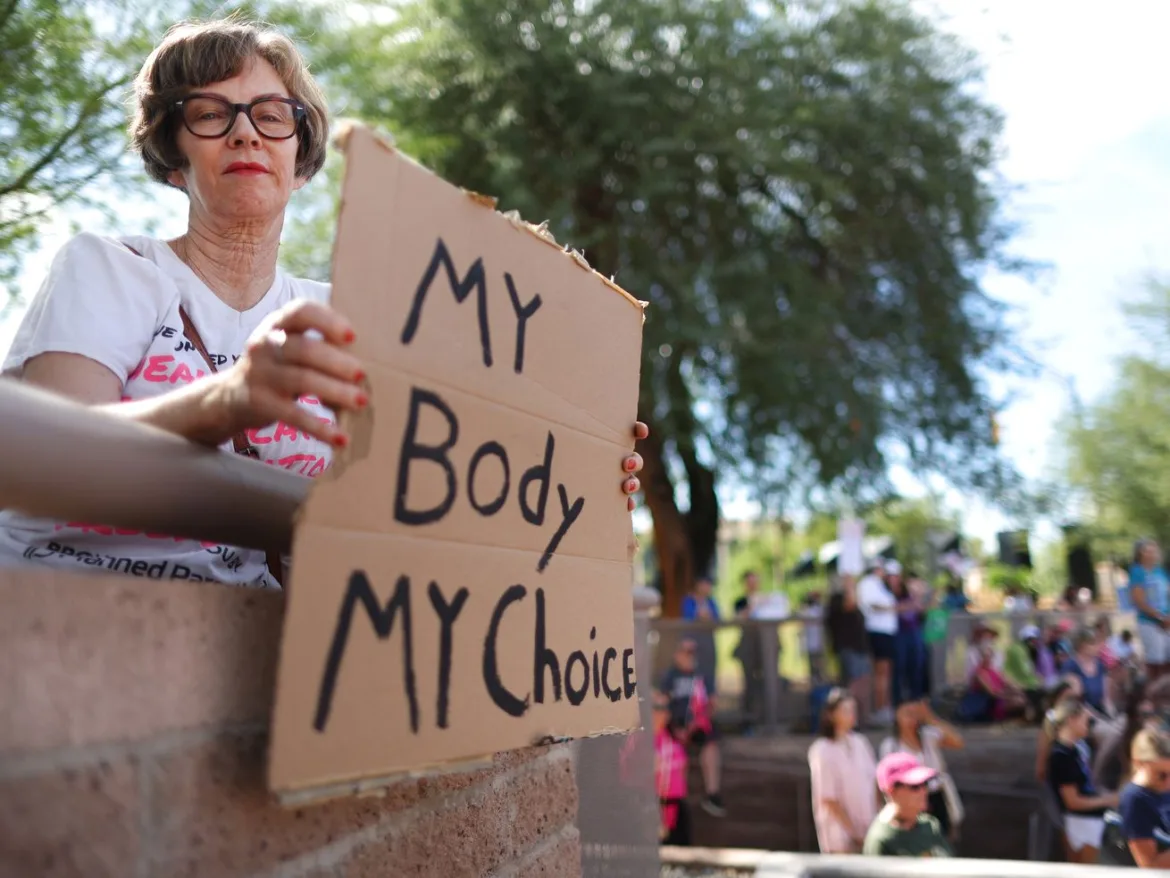How conspiring doctors, questionable tonics, and twisted patriotism led to the 1864 Arizona abortion ban that was just upheld in court.
Earlier this week, the Arizona Supreme Court ruled that a Civil War-era state law that amounts to a near-total ban on abortion can be enforced, putting access to reproductive care for about 1.6 million people of reproductive age under immediate threat.
It’s one of several abortion laws enacted before the Supreme Court’s 1973 decision in Roe v. Wade that have been revived since the justices overturned Roe in 2022. Resuscitating these laws has created legal headaches, in part because they were written in a very different time for reasons that have little in common with the concerns of anti-abortion advocates today.
Arizona’s ban, first passed in 1864 and codified again in 1901 and 1913, says anyone who “provides, supplies or administers” an abortion or abortion drugs will face a state prison sentence of two to five years unless the abortion is necessary to save the life of the person who is pregnant. Taken out of the 19th-century context in which it was passed, that language would seem to amount to a near-total ban on abortion.
But that’s not how the law was originally enforced. Few people were prosecuted under the Arizona law or similar ones in other states. At the time, first-trimester abortions were widespread and widely accepted in the public conscience.
Abortion laws of the mid-1800s were the product of discussions among lawyers and doctors and were designed to professionalize abortion services and medicine writ large — a seemingly noble cause, but also one driven by physicians’ self-interests and the desire to both boost (white) women’s birth rates and weaken a nascent feminist movement.
There was no national abortion debate to speak of. Religion wasn’t yet a major factor in Americans’ views on abortion in the way it is today, and scientists had not yet developed methods to detect pregnancy during the first months of gestation.
All of that meant abortion was a common, if not always safe, part of American life, despite what the old laws might suggest.
“I think people imagine nobody did it because it was illegal. But we know that’s not true,” said Lauren MacIvor Thompson, a history professor at Kennesaw State University focusing on women’s rights and public health.
Abortion was common and widely accepted in the 19th century
For much of the first half of the 19th century, there were few laws in the US that were specifically concerned with abortion. Rather, abortion was understood in the tradition of British common law: It was only a crime after “quickening,” when a fetus’s movement could be detected — around four or five months of gestation. Before quickening, people could be ignorant (or have plausible deniability) about being pregnant.
Generally, the American public at this time had few moral qualms about abortion before quickening. In particular, it was a service that many believed should be offered to unmarried women, who risked reputational ruin if they proceeded with the pregnancy and often came from poor backgrounds, as historian James Mohr writes in his 1978 book, Abortion in America.
But around the mid-1800s, things started to shift. More people appeared to be seeking abortions, not just those who were unmarried. One estimate by physicians at the time that Mohr cites suggests that as many as one in five pregnancies ended in abortion. Partially because of this, birth rates fell dramatically: from 7.04 children per woman in 1800 to 3.56 by 1900, according to Mohr.
Starting around the 1830s, abortion became a lucrative industry. It was still mostly unregulated but perceived as largely safe, especially when weighed against the risks of pregnancy. There is little available data on maternal mortality rates in the US at the time, but even by 1915, after the development of antisepsis, it was about 600 in every 100,000 births — higher than in some European countries at the time. In 2021, the US maternal mortality rate was 32.9 deaths per 100,000 live births.
As Mohr writes, home medical manuals and midwifery texts advised readers on abortifacient substances (such as black hellebore) and practices that could bring about an abortion (such as bloodletting and “raising great weights”). Abortifacient tonics of varying effectiveness were prolifically advertised. Physicians, midwives, and even untrained practitioners offered procedures to clear “obstructed menses.” One abortion provider to the elites, known as “Madame Restell,” amassed a fortune estimated at up to $1 million.
Increased access to abortion seen throughout the 19th century led to increased scrutiny, however, and that led to many of the laws and attitudes still with us today.
The beginnings of the anti-abortion movement
The anti-abortion movement began to take off in the 1850s for a few reasons.
For one, anti-abortionists resented the fact that wealthy, white Protestant women were starting to drive demand for abortions, usually to limit their family size or delay having their first child.
These women were seen as shirking their duties to “republican motherhood” — a concept that involved raising the next generation of productive citizens instilled with the values espoused by the young American republic and that excluded nonwhite women. They were maligned for indulging priorities outside of the home at a time when the women’s suffrage movement was taking shape. Some men were seen as complicit in this phenomenon, urging their wives to get abortions and paying for them.
Anti-abortionists argued that laws specifically restricting abortion were necessary because otherwise, “nice white ladies who don’t want to be pregnant just won’t fulfill their obligation,” as MacIvor Thompson put it.
Around this time, there were also a few highly publicized trials involving botched abortions, typically cases where the pregnant person died. This raised the profile of abortion as a safety issue for legislators.
A broader movement to professionalize the American medical system also contributed to the first laws restricting abortion in the US. The Civil War laid bare the need for more competent medical professionals, and credentialed physicians known as “regulars” lobbied for laws on abortion for the stated reason of protecting people from quacks.
But they also had selfish motivations to essentially establish a monopoly over the market for abortions and sideline their competition. Physicians — who, at that point, were nearly all white and male — had lost income and stature as a result of this competition with other medical practitioners, and performing abortions was a way to attract loyal long-term patients, Mohr writes.
“What they’re trying to do is consolidate their professional dominance because they don’t want to be competing with midwives or competing with what they call ‘the irregulars,’” MacIvor Thompson said. This was despite the fact, she added, that the “outcomes that doctors got in terms of treating patients were really not that much better than people who didn’t have medical training.”
Arizona’s abortion ban came amid a wave of early anti-abortion legislation
The first standalone law to specifically prohibit abortion in the US was passed in Massachusetts in 1845. It made performing an abortion a misdemeanor for which an offender could serve five to seven years in jail and face up to a $2,000 fine — about $74,000 in 2024 dollars — or a felony in cases where the person having the procedure died.
But as would be the case with others that came after it, the law was rarely enforced: No one was convicted under it between 1849 and 1857, according to Mohr. Generally, such early abortion laws mostly did not create penalties for the pregnant person who sought an abortion but only for those who performed them — and messed up.
“Historians have argued that a lot of these initial laws were meant to protect women. They’re either next to poisoning laws, or they’re framed in a way where it’s like, this is to protect women from quacks,” said Shannon Withycombe, a history professor at the University of New Mexico who studies early abortion laws.
Few religious leaders wanted to get involved in abortion politics. Some Catholic bishops espoused the position, as the church does now, that abortion is wrong because life begins at conception. But at the time, Catholicism was associated with European immigrants who weren’t “welcomed into white middle-class American society,” MacIvor Thompson said.
However, Horatio Storer, a Harvard physician who converted to Catholicism in his 40s, set out to consolidate support for anti-abortion laws in the 1850s. He ultimately led the charge to criminalize those who sought abortions and to make the punishment more severe if the person was married. He even pushed physicians and legislators to abandon the earlier understanding of abortion as acceptable before quickening and to suppress it at any stage of pregnancy.
Storer’s writings came to inform anti-abortion legislation across the country, though the physician lobby didn’t agree with everything he wrote. Many believed he had gone too far in framing abortion as a religious and moral issue, insisting that it was really a medical issue, Withycombe said.
But physicians latched on to one particular point Storer made in his 1860 book On Criminal Abortion in America: that “doctors need to be able to practice abortion because there are lots of reasons why an abortion is important for the health and life of a woman,” Withycombe said.
This supported physicians as the definitive source of medical expertise about when and how an abortion should be safely administered over other abortion practitioners. And Withycombe notes that in her readings of medical articles and obstetrical teaching texts of the time, she has found a broad array of circumstances in which physicians believed it was their medical duty to perform an abortion — including circumstances in which failing to do so wouldn’t necessarily result in a pregnant person’s death, such as “pernicious anemia,” “obstinate vomiting,” and “advancing jaundice.”
Withycombe said the 1864 Arizona law was part of a wave of legislation, all with similar provisions informed by Storer’s writings, that swept the West in the 1860s while the Civil War was raging. Colorado passed a ban in 1861, Nevada in 1861, Idaho in 1864, and Montana in 1864. At the time, these states were trying to prove that they were part of modern America, emulating medical licensing laws and protections that had already been enacted in more cosmopolitan parts of the country.
In that sense, the passage of these laws was more about professionalizing medicine than the moralistic arguments that later motivated the 1873 Comstock Act, a federal anti-obscenity law that also prohibited the mailing of “every article or thing designed, adapted, or intended for producing abortion.”
However, Storer’s moral philosophy on abortion did eventually gain traction, and it influenced the next wave of anti-abortion lawmaking in the decades thereafter. About 40 states banned abortion by 1880.
Where the battle over the Arizona ban stands now
Arizona isn’t alone in dealing with a pre-Roe anti-abortion law. Oklahoma is currently enforcing a 1910 abortion ban. Wisconsin’s Democratic attorney general has asked the state Supreme Court to strike down that state’s 1849 ban. Delaware, New Mexico, and Michigan have repealed their pre-Roe bans only in the last few years. West Virginia’s 19th-century ban was blocked in court in 2022, but the state legislature moved quickly to codify a new abortion ban that allows few exceptions.
The Arizona ban won’t go into effect until at least April 24 under the court’s ruling Tuesday. In the meantime, Democrats in the state legislature want to repeal the law and Republicans have stymied their attempts to do so.
As part of the ruling, the state must ensure the 19th-century law is “harmonized” with a ban after 15 weeks of pregnancy passed in March 2022. It’s not yet clear, however, what that means in practice.
Arizona Attorney General Kris Mayes, a Democrat, has indicated she would not enforce the 1864 ban. Even limited enforcement would look very different from the way the law was interpreted in the years immediately after its passage.
As mentioned, enforcement was spotty in the 19th century, and unlike now, abortion providers continued to operate despite facing potential legal repercussions. Producers of abortifacients often circumvented bans by using euphemistic language to describe their products.
Early abortion laws, including the Arizona ban, also empowered physicians to make decisions about abortion. “A lot of these laws were at least supported if not written by physicians,” Withycombe said. “Physicians agreed that they have complete discretion over whether an abortion is medically necessary.”
However, doctors have often been sidelined in the enforcement of abortion bans post-Roe, with many choosing to leave states with restrictive laws because they feel they cannot perform lifesaving care.
The medical and popular understanding of pregnancy and abortion has also evolved since 1864. We can now detect pregnancy much earlier than “quickening” using urine and blood tests. In the 1860s, early abortions were generally seen as morally equivalent to contraception, Mohr writes — a concept that the American right largely rejects today.
“These laws are being upheld as proof that everyone was completely against abortion in all cases, from the moment of conception,” Withycombe said. “Given the understanding of human development at the time, that is not true in the 1860s.”



